The writing and the Berber script (Tifinagh) is one of the oldest discovered scripts, before the Phoenician and the Yemeni ones
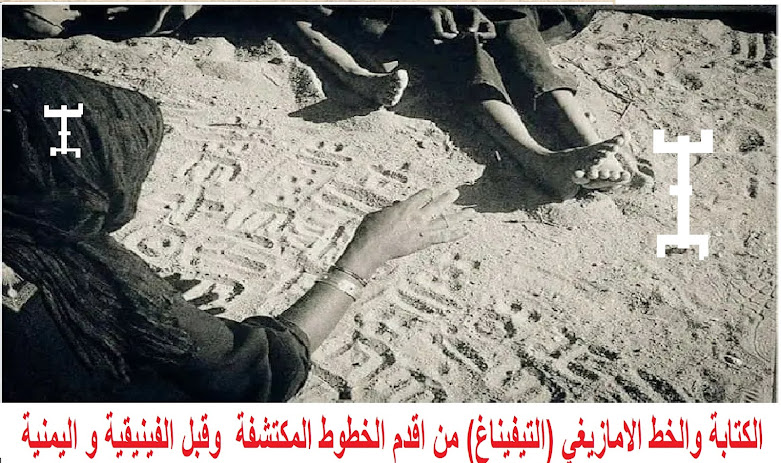
The Lubyan writing, or the Tifinagh, or what we call it now, is the old Berber writing
This original Libyan writing is very old before history and older than the Arabic calligraphy, the Phoenician calligraphy, and the Yemeni ascribed calligraphy, as we will discover during this topic.
And the Libyan Amazigh script did not disappear at all throughout these ages and remained used by the Tuareg Berbers in the south of the Great Amazigh Morocco, and they kept it until the present time.
During the French occupation, the prison administration of Algiers, the capital , found one of the letters that aroused their interest, which is for a group of Tuareg prisoners in the French prison, where 7 prisoners were, and they found individual and collective letters written by those Tuareg to their families
The French administration was astonished by this strange writing that the Tuareg were writing in and presented it to the specialists, to research it and reveal its content, and among the specialists was the researcher Louis Reine, who specializes in the language of the Lobby and specializes in the origins of the Berbers.
The seven Tuareg prisoners with the letters are: Knoun, Aumumen and Mastan, and Tasha from the Taykok tribe, and Shekat and Akor from the Kal-Ahnat tribe.
In the following picture, one of the messages is written in the old Amazigh lobby for the Al-Ahghar region and written from left to right
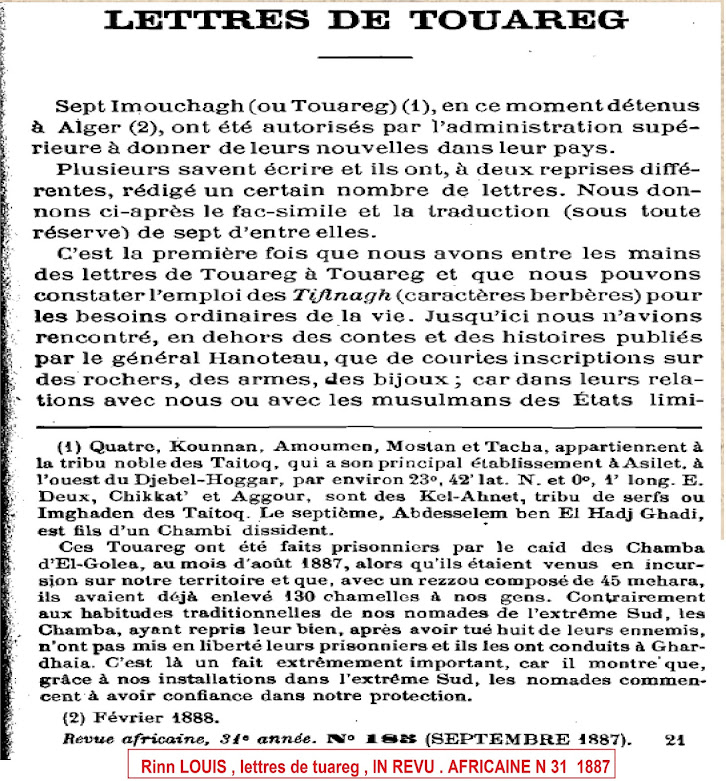
This information is found in the book The Tuareg Letters of the researcher Louis Reine for the year 1887
The text is available in the African Journal, Issue 31, 1887 AD
Rinn LOUIS, lettres de tuareg, IN R. AF
https://www.algerie-ancienne.com/livres/Revue/revue.htm
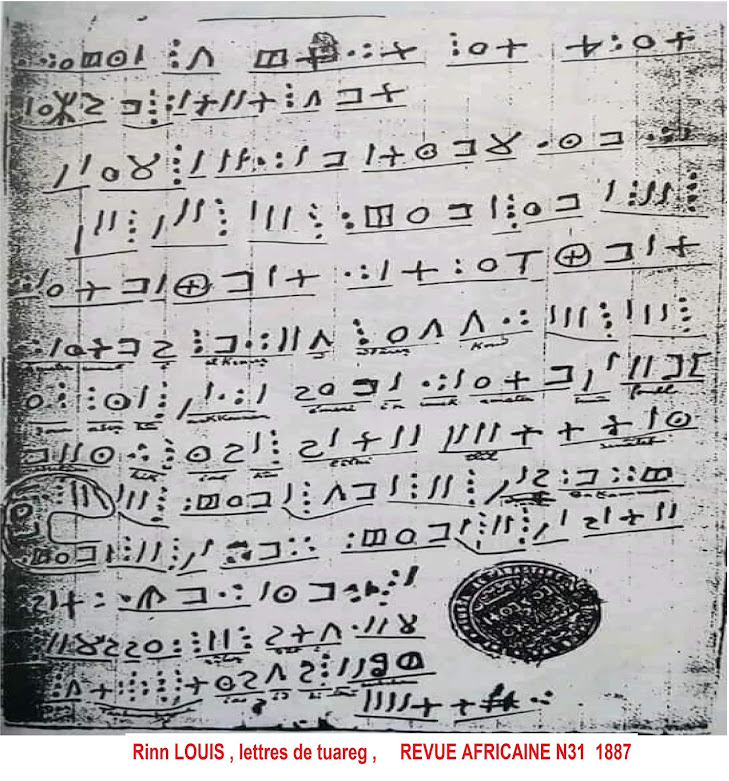
If this line, which the ancestors of the Berbers wrote thousands of years ago, and the Berbers are still writing and learning in schools and universities, and taught by the Turkic Berber mothers in the far south of the Sahara, is it an authentic Berber script, or a Phoenician or Yemeni script, as promoted by Arabist nationalists in North Africa?
Of course, the Tafinagh Berber script is a gradual development of ancient letters, which is scientifically known as the Libyan Berber script, which is found in all regions of northwest Africa, as indicated by the following map.
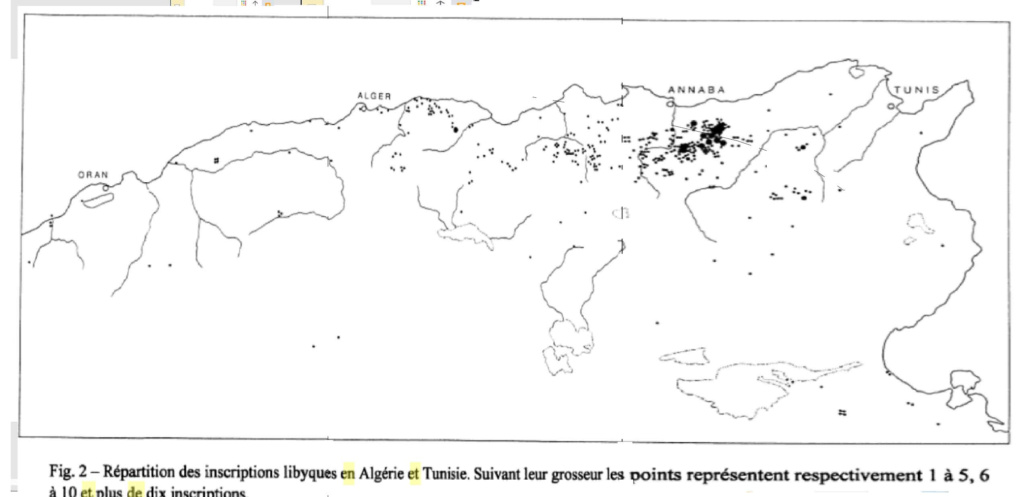
Source researchers page 57 of the book
Claude Lepelley , Xavier Dupuis
Frontières et limites géographiques de l'Afrique du Nord antique
https://books.google.dz/b%20en%20Afrique%20nord&f=false
The meanings of the Amazigh letters
Ref
Dechiffrages. Quelques réflexions sur l'écriture libyco-berbère
Deciphering: A few thoughts about the Libyco-Berber script
Dominique Casajus
https://journals.openedition.org/afriques/688
German researcher, orientalist and expert on oriental languages, Franz karl Movers, and through his studies on the ancient Phoenicians, presented his main work, Die Phonizier, in which he gained wide fame, as he conducted detailed and in-depth studies on Phoenician history. ahead of the Phoenician alphabet; Where can one rightly conclude that the Berbers knew writing before the Phoenicians? Furthermore, Movers asserts that civilization among the Libyan peoples of North Africa dates back far beyond the founding of Carthage and is older than all the Phoenician colonies in North Africa, and that it is also not surprising to see some Latin words can derive from the Berber language.
Source:
Die Phönizier: Das phönizische Alterthum. II Theil : Geschichte der Colonien. Berlin 1850, page 406 et suivantes
https://books.google.dz/books?id=bW06AAAAcAAJ&printsec=frontcover&dq=Das+ph%C3%B6nizische+Alterthum+1850&hl=en&sa=X&ved=0ahUKEwiyqJqCrP3pAhWR3OAKHQ4fCaIQ6wEIKjAA&fbclid=IwAR3ih3M_ZcJBxDlIJp8-SMgDuhpnremKfMluZGAXUzctTwRHogofKCuAWc4#v=onepage&q&f=false
Let you know, the age of Tifinagh is estimated at three thousand years BC, as confirmed by archaeologists recently, that the alphabet of the Berber language is 5,000 years old from the present, making it one of the oldest and oldest languages in human history. Phoenician in the Levant, for example, appeared only 1200 years BC. Al-Misnad Al-Himyari appeared only 900 years ago BC.
This impressive archaeological discovery (the Libyan Amazigh line) was found in the southeast of Morocco and on the flanks of the Draa Valley, the largest and oldest Neolithic cemetery assemblies in Morocco in the form of small pyramids known as TumulusIt is dated about 6000 thousand years BC and perhaps more, which corresponds to the Neolithic Neolithic period, and these images are accompanied by ancient Berber writings.
With these discoveries, the Berber Tifinagh discovered in the Great Maghreb became one of the oldest writings in the world, bearing in mind that Africa in general contains the oldest writings in the world
. We mention the Proto-Saharan script
, which appeared in northern Sudan until the borders of present-day Libya, where its estimated age is about 5200 years. BC. It is considered one of the first writing attempts. As for the Tifinagh script, which is a script with complete rules, its age is estimated at 3000 BC. See the following link: http://www.taneter.org/writing.html

A new reference from the year 2020 AD talks about the age of the Amazigh script about 3 thousand years BC, and this is through the statement of the researcher in archeology (Ahmed Skounti), who studied three drawings in the Far Maghreb and with them Berber writings in Tifinagh, the study gave three ages for each of those The first drawings are 7 thousand years before the present, the second is 5 thousand before the present, and the third is 3 thousand years before the present, and this means that the Amazigh writing existed and lasted at least from 5 thousand to 3 thousand to a thousand BC
Nous avons nous-mêmes, avec des collègues Marocains et Italiens, publié la datation des peintures d'Ifran-n-Taska, dans le Bani oriental en 2012. Trois échantillons ont donné les dates approximatives suivantesème, 5ènétaire 3ène millière 3ènétés : 7 present. La plus basse qui est du 3e millénaire avant le présent correspond au premier millénaire avant J.-C. Les peintures datées sont associées à quelques inscriptions peintes.
Le Tifinagh, la singularité berbère gravée dans le temps
Par
Ahmed Skounti
and
Eric England
https://sudestmaroc.com/le-tifinagh-la-singularite-berbere-gravee-dans-le-temps/
Away from the French sources on the history of North Africa and the antiquity of the Tifinagh:
This is a foreign research in English about mythology and ancient symbols in which he talks about the ancient Liberian alphabet that was found in the pyramid of Khufu in Egypt by the methods of an American research team in 1986 and the author of the article returns it to 12,000 years BC We repeat and repeat twelve thousand years before the appearance of the Phoenicians on the stage of history Thousands of years before the appearance of the Musnad and Thamudi line thousands of years as well. He also talked about the Tifinagh in the Tasili and dates back to the eighth millennium.
http://www.joseluisespejo.com/index.php/hidden-history/350-la-rodilla-de-hercules?fbclid=IwAR0F1l9rr-t28lETYszURQQAJCVZCeD7Bgmrg7eLsqLOJDSOW4Cy5RL7yFY
A picture of the letters of the Tafinagh in the monuments of Egypt and in Tasili, taken from the research

Insriptions on the ancient door of entrance of the pyramid of Cheops. Compare it with the old tifinagh writing (up to the right)
These are pictures of the letters (Libyco-Berber) or ancient Tifinagh that are 9,000 years old (nine thousand years), according to estimates by researchers from the depths of the Tassili desert in Algeria.

The tifinagh inscriptions in the Tassili, in the center of the Sahara, are accompanied by curious drawings of a culture very flourishing, dated some 9,000 years back (according to the antiquity of its pottery, of the VIII Millennium aC.)
Linguist, linguist and archaeologist Tim Brooks confirms that writing Tifinagh
In the Amazigh Maghreb, it is the oldest writing ever
Tim Brookes discusses Tifinagh, the astonishing writing used by the amazigh (Berber) people of North Africa. This can be found in his book "Endangered Alphabets" athttp://www.endangeredalphabets.com.
The archaeological discoveries showed that there were two different scripts, Libyan, Berber, and another Phoenician script, as is known, Tifinagh. It was written from bottom to top, and this language was the official language of the kingdom. The evidence is the inscriptions of the Berber king Masinissa (Mas Nesin, meaning the master of the people), who was writing on the rock in Tifinagh. First, then he translates in the language of his first allies, ie the Phoenicians, in what remains of the rock, and this is another evidence of the independence and priority of Tifinagh. If it was derived from the Phoenician, why was he writing Masinissa in both languages? Is there anyone among you who saw a European ruler writing in his own language and then repeating it in Latin?
For those who want to be sure of this fact, they should study the research of Dr. Bahjat Qubaisi, one of the pillars of the Arab Baathists in Syria, who confirmed what we said earlier.
The painting is kept in the Louvre, France
. Cliché Sophie A. de Beaune.

Moulage de la dédicace à Massinissa

The same discovery was confirmed by Western researchers such as Dominique Casajus
search link
S ur l'origin de l'écriture libyque. Quelques propositions
On the origin of the Libyco-Berber alphabet
https://journals.openedition.org/afriques/1203
In the summary of the researcher’s words, he says that the discovery of the Libyan calligraphy next to the Phoenician calligraphy confirmed that the two writings are different from each other and that the Libyan calligraphy has existed since antiquity
and is based on the study.
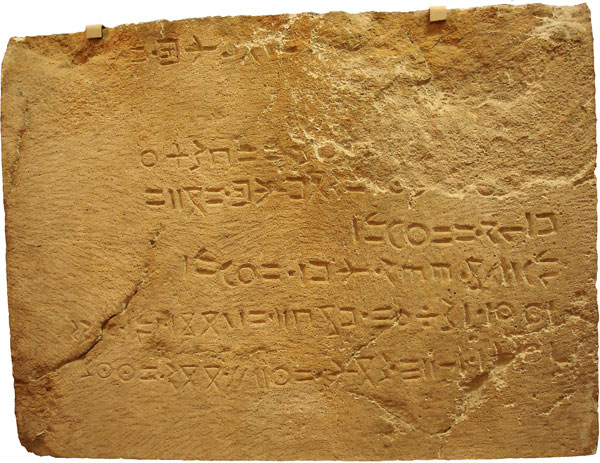
A second example of the traces of a double inscription in the Berber and Neo-Punic monument
is a bilingual monument, inscribed with the Berber Tafinagh letters accompanied by another inscription in the Neo-Punic language, dated from the second century AD, and discovered on the site of the city of Lixus in Morocco.
On display from the Kasbah Museum in Tangiers, Morocco.
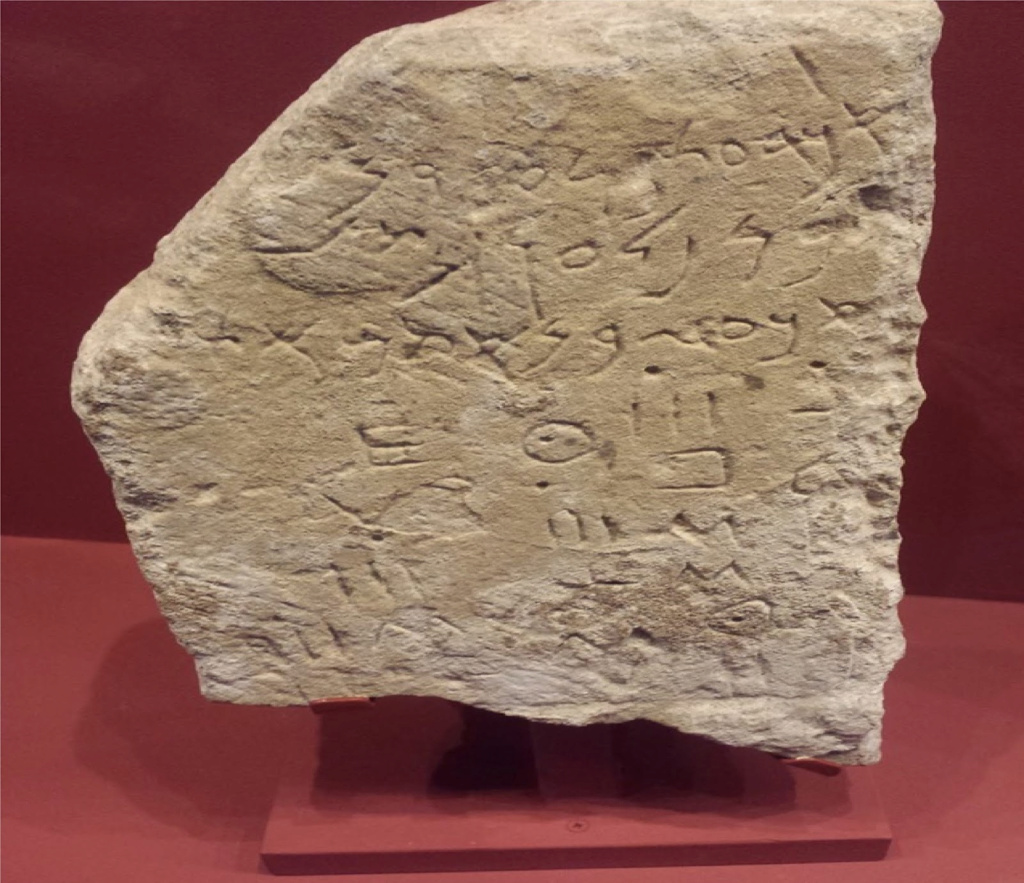
The identification shot of the inscription

Bilingual inscription, Libyan, not Latin

A picture of a funerary monument discovered in Shafia in the Wilayat of El Tarf and is currently in the Hibbon Museum (and all the Libyan inscriptions in the Hibbon Museum were not discovered in the archaeological city, but rather in the Shafia) in Annaba that contains a Latin-Libyan double text.
Latin text:
SACTUT IHIMIR F VIXIT ANORVM LXX H[SE]
Translation:
Saktut Ibn Lahimir lived 70 years and is buried here.
The Libyan text:
ZKTT WYMR MTYBLH MSWH MNKDH,
the first and second words, of course, their meaning is Siktoot bin Lahimer. As for the third word, it is believed to be a tribe or a city, and it was suggested that it was the site of the Roman Tipilium. The rest of the text is incomprehensible.
It was believed that this writing appeared in the second century BC after the discovery of the Dougga inscription in the Libyan and Phoenician languages, which dedicates the date of 138 BC. It was completed by the "citizens of Thugga" to perpetuate the memory of King Masinissa, although this inscription I had raised a logical question that was a major obstacle to the advocates of the theory of the Semitic origin of the Libyan Amazigh alphabet, which is the reason that prompted the Berbers to invent a new writing of Phoenician origin and write a tick inscription in two alphabets and two languages instead of the Phoenician alphabet only if the Libyan alphabet did not exist before the arrival of the Phoenician? Link to the topic by the researcher Leonel Galand , L., 1973a, « L'alphabet libyque de Dougga », Revue de l'Occident musulman et de la Méditerranée https://www.persee.fr/doc/remmm_0035-1474_1973_num_13_1_1216
The historian Friedrich J. Friedrich, who rejected the existence of any relationship between the Libyan alphabet with the Semitic writings, and among the logical evidence he provided:
1 - There is no similarity between the Libyan letters and the Semitic ones, except for a very few letters.
2 - Semitic writing does not record initial consonants, unlike Libyan.
3 - The most important evidence is that the original Libyan writing begins to be written from the bottom up and from left to right, in contrast to the Semitic writings, including the ancient Arabic and Phoenician ones. (J.Friedrich, zdmg, 91,1937, p.334)
Another reference that speaks and documents the discovery of the Tafinagh script (Libyan) with a translation in the Punic script.
The title of the book
is Recueil des inscriptions libyques Link to view https://halshs.archives-ouvertes.fr/halshs-00841800/document
The researcher and historian Malika Hashid, who worked for seven years in the Tassili Nature Reserve in the dens, as an anthropological researcher, is the owner of the rich discovery that turned the equation and the concepts. Between a thousand years BC and one thousand and five hundred years BC, which cut doubt on the ancientness and authenticity of the Libyan-Amazigh writing in North Africa, and with this discovery, the hypothesis of Gabriel Camp, who saw that Tifinagh could not have appeared in a time less than a thousand years ago, was fulfilled. B.C.E .
Malika Hashid has written a very important book entitled "The early Berbers between the Mediterranean, Tassili and the Nile River."
(LES PREMIERS BERBERES Entre Méditeranée Tassili et Nil)
The book contains more than 350 pages, in which I presented an in-depth academic research, in which she answered the questions of previous historians about the origins of the Amazigh, and the originality of the Libyan alphabet, which the first Berbers excelled in reducing and converting symbols and images to phonetique. This is what made many researchers suggest that the Libyan writing is one of the oldest phonetic writings known to man, which provides strong evidence that the origin of the southern Arabic writing (the Musnad line) was derived from the Libyan writing or took some of its letters, because the Musnad line is a modern comparison. In the Libyan script and dates back to only 900 years BC, it developed into its classical form in the sixth century BC
(Rodolfo Fattovich, Encyclopaedia Aethiopica: AC, Harrassowitz Verlag, 2003, « Akkälä Guzay », p. 169)
The Tafinagh Berber is thousands of years older than the Phoenician line
The oldest discovered Phoenician writing dates back only to about 1050 BC, while the Berber Tifinagh script discovered in North Africa, especially in Morocco, has a maximum age of 6 thousand years.
The Phoenician Alphabet was discovered on the tomb of the Phoenician King Ahiram , King of Byblos. This inscription was discovered by Montet.Pierre Montet in 1923 in the fifth tomb in the town of Byblos on the Lebanese coast, written on the lid of a coffin with drawings related to the subject of the inscription; A scene appears in it representing the dead king eating a ritual meal, and carrying a lotus flower, which has been hanging down, to indicate that its bearer is dead. This is an artistic element that has its counterpart in the ancient East.
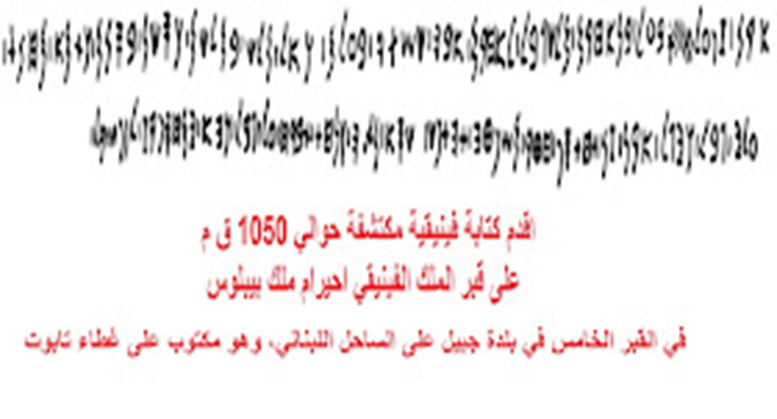
a r n / g o l [/ a ta b a l / a n a rt m / m a ll c c c b l / a a rm / a b e / k t ah / ba l m /
f al / m l k / b m l k m / f s k n / bs (k) n m / t m a / m h n t / u l y / c b l / y jl / a r n/g n/t h t t/h t/m u ft ih/t htfk/ s a/ m ll kw h/ w n ht/ t br h/ ll / JB L/ F H H / Y M H S F R A / L F N J B L
inscription translation
The chest which [E]Tobaal the son of Ahirum, king of Byblos, made to Ahirum, his father, having placed it for eternity.
And if a king among the kings, and a governor from among the [states], and a leader crawled on Byblos, and this coffin was revealed, it may be that the scepter of his rule will peel off, and the throne of his kingdom will be overturned, and peace will depart from Byblos, as he erases his scroll, in front of Jbeil.
Video about the oldest Phoenician writing discovered in Hawallib 1050 BC
Picture of the tomb of the Phoenician King Ahiram, where the oldest Phoenician writing

The Phoenicians learned to write from the Berbers of North Africa
As for the Phoenician writing, which historians confirm that the Phoenicians took their alphabet from the Sinai writing (relative to the Sinai desert) in Egypt, (Philip until, History of Syria, Lebanon and Palestine, vol. 1, p. 120), and if we know that the oldest document of Phoenician writing was found in the city of Byblos in Phoenicia. It was in the tenth century B.C. (The Phoenician Ghobri Al-Mositate Expansion. Muhammad Ghanem, p. 24). It is a modern date compared to the date of the emergence of the Libyan writing 1500 BC.
James (G.) Fevrier , op. cit , pp. 322- Thus, historians and archaeological discoveries confirm the originality and presentation of the Libyan Amazigh writing.
German researcher, orientalist and expert on oriental languages, Franz karl Movers, and through his studies on the ancient Phoenicians, presented his main work, Die Phonizier, in which he gained wide fame, as he conducted detailed and in-depth studies on Phoenician history. ahead of the Phoenician alphabet; Where can one rightly conclude that the Berbers knew writing before the Phoenicians? Furthermore, Movers asserts that civilization among the Libyan peoples of North Africa dates back far beyond the founding of Carthage and is older than all the Phoenician colonies in North Africa, and that it is also not surprising to see some Latin words can derive from the Berber language.
Source :
Die Phönizier: Das phönizische Alterthum. II Theil : Geschichte der Colonien. Berlin 1850, page 406 et suivantes.
https://books.google.dz/books?id=bW06AAAAcAA&fbclid=IwAR2Eq1fx3Rw_Wo90XmwYuJsaHmV3AZmT75Z3E2s-rJMZV3LcjNc0y5B0XTk#v=onepage&q&f=false
Exposing the lie of the Libyan Amazigh writing of Yemeni Arab origins
What is the truth of the Arab nationalists’ claim that the Libyan Amazigh writing is of Yemeni Arab origin? Is the right of the assigned script an authentic Arabic font, or does it come to Yemen? What is the academic and logical evidence that proves this?
First, we have to agree on something, which is that the idea of returning the Berber alphabet to the Musnad is the idea of Arab nationalist writers only recently emerged and Western historians who studied the history of North Africa did not say about it.
Also, the old Libyan Berber or Tafinagh Berber line is about 3000 BC, while the oldest Yemeni line (Al-Musnad) dates back to about 1200 BC, which is the predicate that appeared with the beginning of the first Yemeni civilizations such as the Sabaeans.
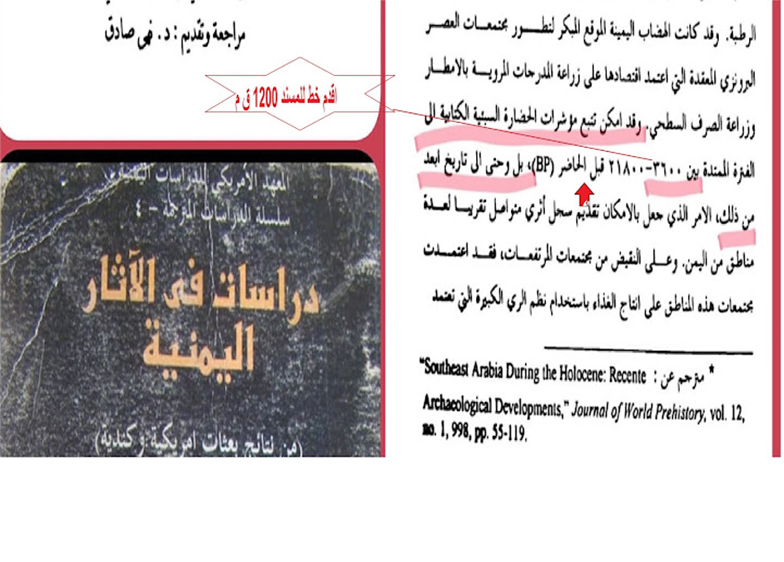
We consider this idea from the myths of Arab nationalists and Arab historians who lack any academic scientific logic. The truth is that any human being who possesses a simple historical culture can realize the extent of the trivialization and fraud practiced by some who call themselves writers and historians with academic titles. They tried to return the ancient Libyan writing and Tifinagh to a Yemeni Hijazi origin and link it In the Musnad script, which they call the old Arabic calligraphy, in which we find some inscriptions in Yemen, so follow this video that we chose as an example because many Arab nationalists publish it on their pages to prove that Amazigh is from the origin of the Musnad script, although the video itself belies them, but because Arab nationalism has blinded them They didn't notice it.
video link:
In the first clip of the video, the speaker, Dr. Eid Al-Yahya, says that the script is an old Arabic script, and at the same time he says that the one who wrote it was the royal scribe of the Abraha army, Ibn Al-Sabah Al-Ashram, the Ethiopian (currently Ethiopia) king of the Kingdom of Aksum, see minute 4.20. It is known In Islamic history, Abraha, who led the army of elephants to destroy the Kaaba, was in the year of the elephant in which the Prophet of Islam was born in AD 571. This means that this line (Musnad) is a very modern line, written by the Ethiopian Ethiopians when Yemen was their colony, as confirmed by the Greek historian Prokop that in The fifth year of Emperor Justinian's reign, around the year 530 AD, the Abyssinians took over Yemen and seized it.
This is what Dr. Eid Al-Yahya admits in the video as well. On what basis did he say that the predicate script is an Arabic script? There is no logical answer to this question, because there is no logic to these Arabs, except that it is certain that they were Arabs, even the Abyssinians. Ibn Hazm al-Andalusi believed in them in the tenth century AD when he said that the historians of Yemen were liars.

As for the similarity between some of the letters in the Musnad and the Amazigh, this is a very normal matter due to the geographical proximity and the cultural influence between the Ethiopians and the Amazigh who lived together during the ancient centuries, as we got from the ancient news, and as depicted by us from the inscriptions of the Garment and the Berber Jetoulians as they ride their godmothers and run after the Ethiopians.
And if we know that the Libyan script dates back to the third millennium BC, and its estimate is less than 1500 years BC, according to what was confirmed by the Algerian researcher Malika Hashid, a historian and archaeologist who conducted tests with radiocarbon technology on Tifinagh, and it was found that it dates back more than one thousand and five hundred years. BC, meaning in any case, it is older than the Yemeni script
(See her book:
LES PREMIERS BERBERES Entre Méditeranée Tassili et Nil )
https://gallica.bnf.fr/ark:/12148/bpt6k1002399z/f2.item.texteImage
This simply means that if we want to find a relationship between the Musnad and the Amazigh script, we only have to say that the Musnad is of Berber origin and moved from North Africa to Yemen through the Ethiopians.
Follow no really more
https://origineamazigh.blogspot.com/2018/11/blog-post.html?m=1&fbclid=IwAR1GnejOn1tJCWPQsU0ekncnxH6zmrX4cajIqY69yxCFiqpNQsNASBd9k44

